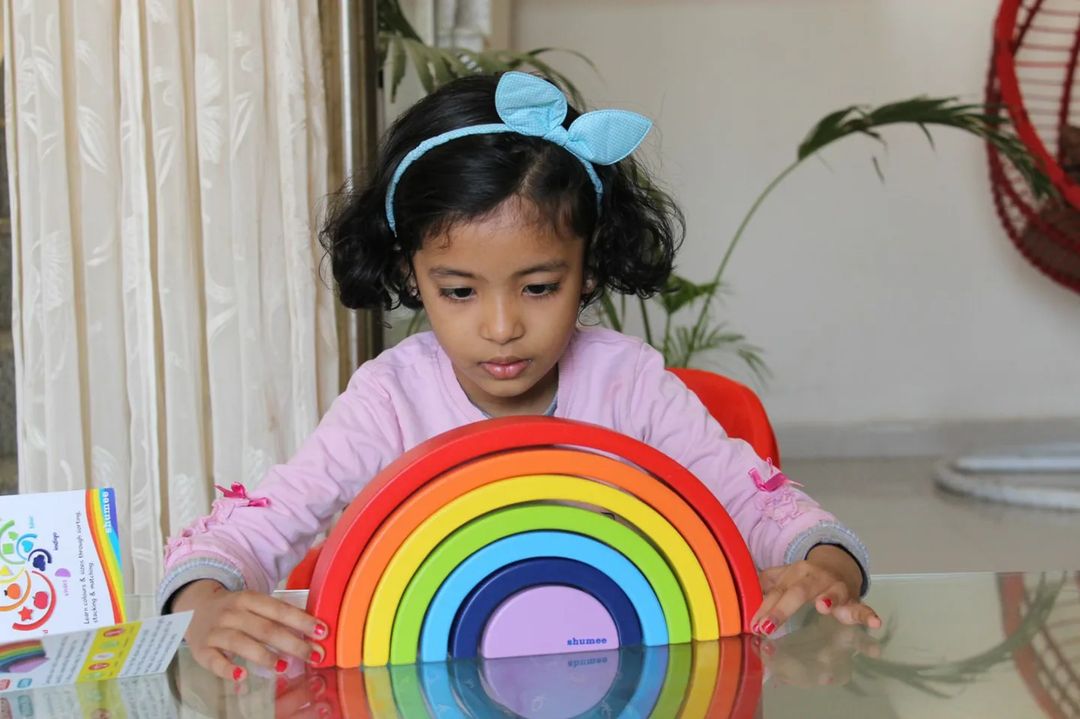“Play is the work of the child” – you may be familiar with this famous quote by child psychologist Jean Piaget. From Montessori classrooms to parenting blogs, we commonly use it to reiterate how essential play is for young children.
In the 1900s, another childhood development researcher Mildred Parten proposed that just like work, there are different levels and types of play too. She observed that children engage in six types of play depending on their age, skills, and interests.
Today, learning experts have taken her work further and divided play into 11 different types. Read on to find out where your child may be at and how you can help them grow through play!
The 11 types of play
1. Unoccupied Play
What is it: This type of play typically happens from the time a child is born until they are about three months old. You may not even clock it as ‘play’ as unoccupied play is mostly about babies looking at everything, taking in the world, and moving their arms and legs with no major purpose.
Play ideas: At this stage, your baby does not need too many toys to play with. A play gym or a couple of cute rattles will go a long way in sparking their curiosity and keeping them happily engaged.
Want to set up a play area for your baby? Do it in just 5 simple steps! |
2. Independent Play
What is it: Independent play, also known as solitary play, is when your child plays by themselves. Between one to three, children develop awareness of themselves and enjoy exploring it through play. They are also just beginning to talk and communicate, so engaging with others will be a challenge at this stage.
However, children of all ages can play independently every now and then. If your child is a little shy or enjoys quiet play, this might even be what they prefer, and that’s completely alright!
Play ideas: For toddlers who are learning to play with toys, soothing rattles, sensory cubes, and stackers are great choices. For preschoolers, you could try out cuddly buddies and lacing toys.
3. Onlooker play
What is it: When we think of playing, we think of a child doing something active. But one of the most powerful types of play for toddlers is onlooker play. Here, children simply observe their siblings, peers, or parents as they play or go about doing other activities. This helps them learn about social cues, get comfortable before inserting themselves in unfamiliar spaces, and teaches them how to do new things.
How to play: Although onlooker play is more about observation, children may occassionally want to try recreating what they see. You could invest in play sets like a kitchen set or get them to join in and help you with whatever you are doing!
4. Parallel Play
What is it: Watching parallel play at first can feel confusing – it’s two children sitting side by side, each completely immersed in their own little worlds! But fear not, children learn to play beside each other before they can start playing with each other. Parallel play builds confidence and communication skills.
How to play: Pretend play toys, art toys, and DIY sets are parallel play favourites. Some basic stationery also goes a long way in having fun at this stage!
5. Associative Play
What is it: At around three or four years, you will notice something fascinating happen when kids of the same age get together. They won’t be playing with each other, but will be involved in each other’s play. This is called associative play.
Here, kids may use the same set of blocks to make their own structures or may decide on a common theme and draw their own interpretations of it. This hones several skills such as communication, active listening, and problem-solving.
How to play: Unlike independent play or even pretend play, children who are engaged in associative play typically play in the ‘same world’. Games here could involve blocks, DIY building sets, skipping ropes, and pretend play toys.
One toy, many learning possibilities — Don't miss shumee's wooden play sets with peg dolls! |
6. Cooperative Play
What is it: At four or five years, your child will start to make use of those social skills they've been honing and play with others. This is called cooperative play and helps further their communication skills and emotional intelligence.
How to play: The best part of cooperative play is that the real enjoyment isn’t in a game or toy, it's all about the company! Depending on your child’s interests, they may want to work on puzzles with a friend, play board games with siblings, or go on swings and slides in the playground.
7. Constructive Play
What is it: At this stage, your child will enjoy building things. Here, they learn to manipulate different objects and the simple science behind making things work. As you can tell, this type of play also falls under many others like parallel play, independent play, and associative play.
How to play: Blocks, arches, magnetic toys, and doll houses are all excellent at this stage. For constructive play, your child may also love building sand castles or playing DIY at-home games!
8. Competitive Play
What is it: Once your child has learnt cooperative play, competing through play isn’t far behind! This is a crucial stage in your child’s journey as while playing against someone, they learn sportsmanship, taking turns, teamwork, and how to win and lose gracefully.
How to play: From team sports to obstacle courses to board games, there are endless ways to engage in competitive play. Your child will certainly come up with tons of ideas to ‘see who wins’ at simple things – all part of the fun!
Want to set up a fun and easy obstacle course? Read this blog to find out how! |
9. Physical Play
What is it: Once they are toddlers, most kids begin to run around and explore their world. This type of play hones fine and gross motor skills that your child will need to move confidently, hold a pencil, and eat on their own.
How to play: Activities like climbing a Pikler or riding a bike will be instant hits with children who enjoy physical play. A balance board, skipping rope, or even playing tag might be equally exciting!
10. Dramatic Play
What is it: Dramatic play, better known as fantasy or pretend play, begins at about three or four years and is about the make-believe. This is a great way to exercise the imagination, makes way for creative thinking, improves social skills, betters vocabulary, and hones emotional intelligence.
How to play: Every child’s toy box needs a few great pretend play sets! But kids could have just as much fun playing dress up with mom’s dupattas, stealing a few ingredients from the kitchen to make their own dishes, or re-enacting their favourite children’s show episodes!
11. Symbolic Play
What is it: Symbolic play is all about self-expression! Be it through rhymes, making music, or creating art, at this stage, your child’s play world will be all about exploring their thoughts and feelings in creative ways. This helps them build a sense of self, understand their emotions better, and feel confident in their ability to express their needs and desires.
How to play: Musical instruments, drawing boards, colouring books, or playdough are great ideas for symbolic play. Kids looking to express themselves will find a way with very little – a piece of paper and a crayon, making music with pots and pans, or squishing atta are all excellent at-home alternatives.
A note of different play stages
Now that you are familiar with each play stage, it’s time to help your child lean into where they are at! Don’t forget that these stages don’t necessarily occur one after the other. They may happen in any order, or even together. In fact, your child may return to previous stages at a later point too.
All of this is completely alright. Trust your child to know exactly what they need, and join in the fun as they play, learn, and grow!






